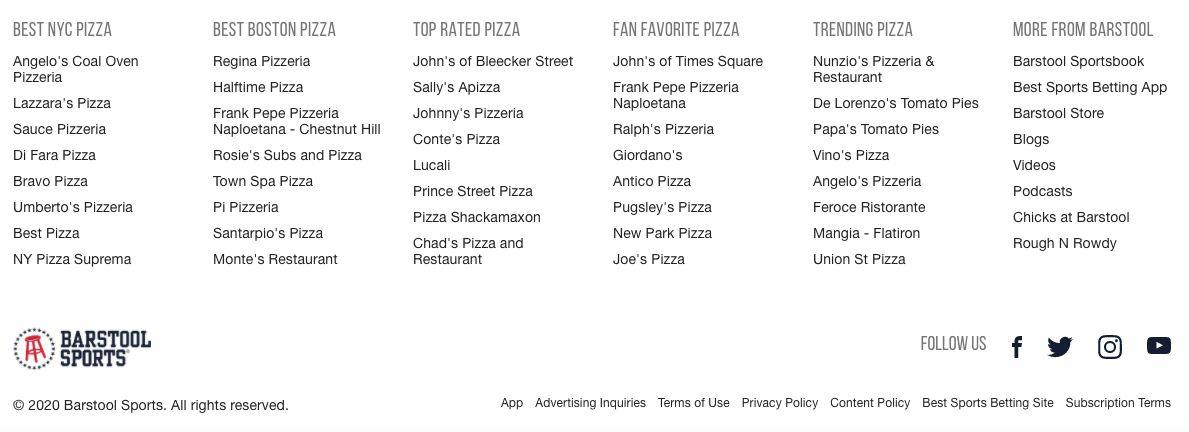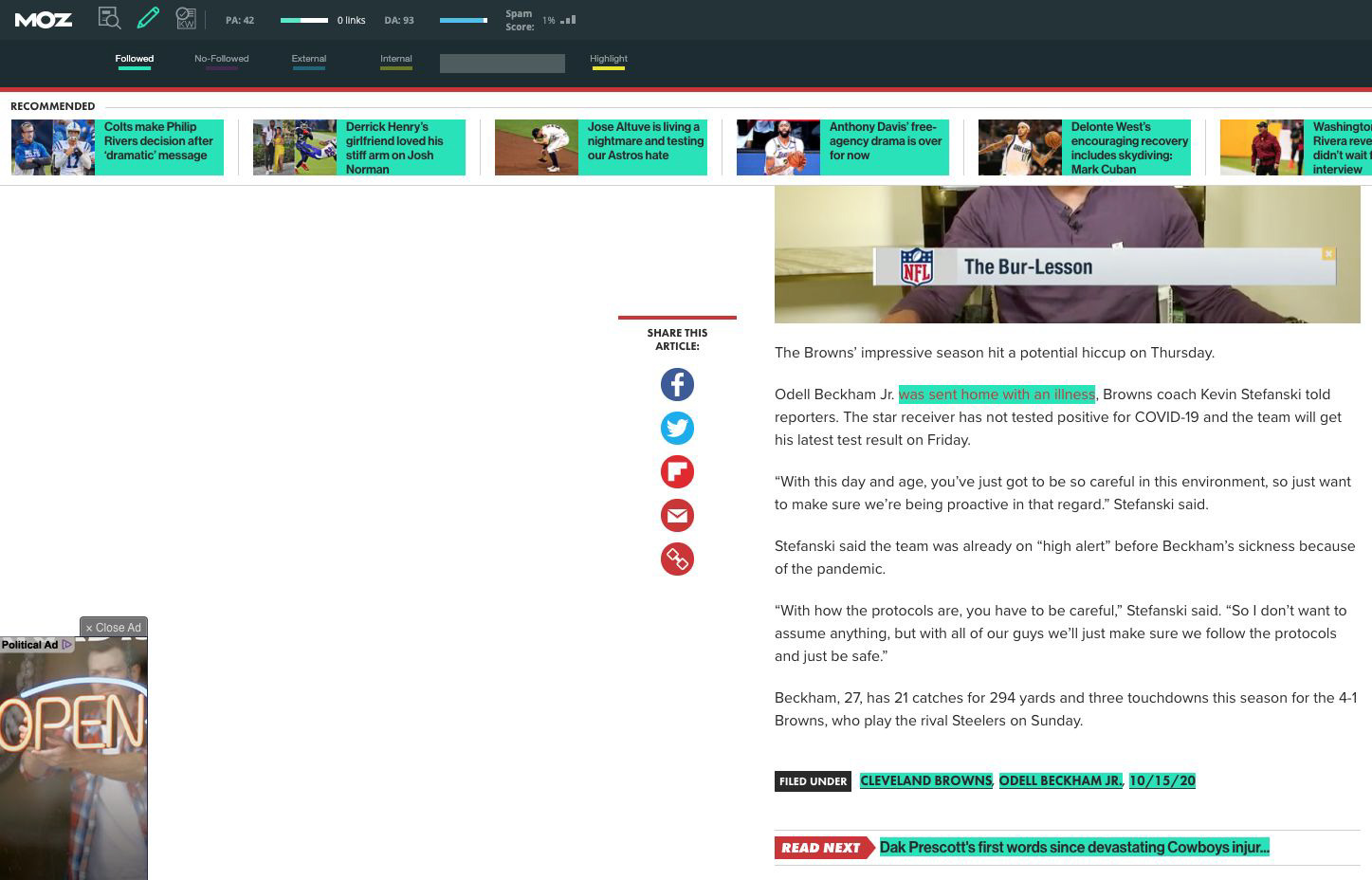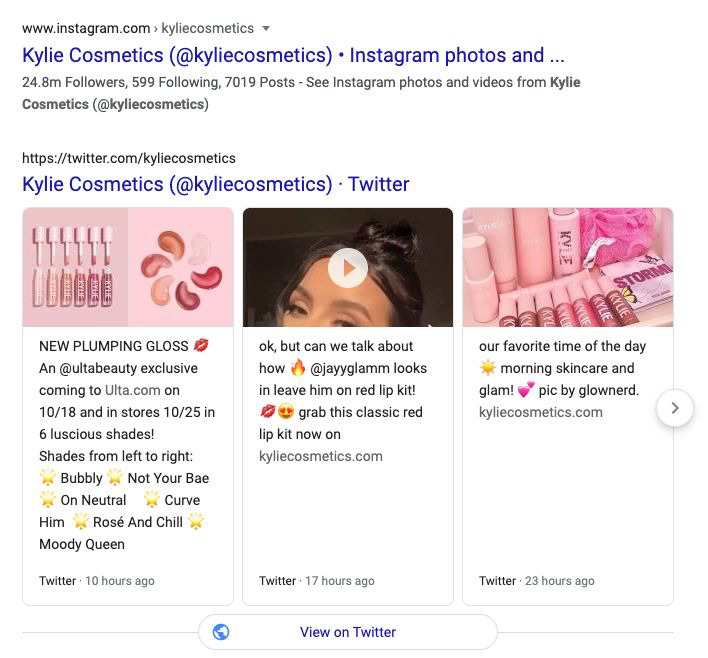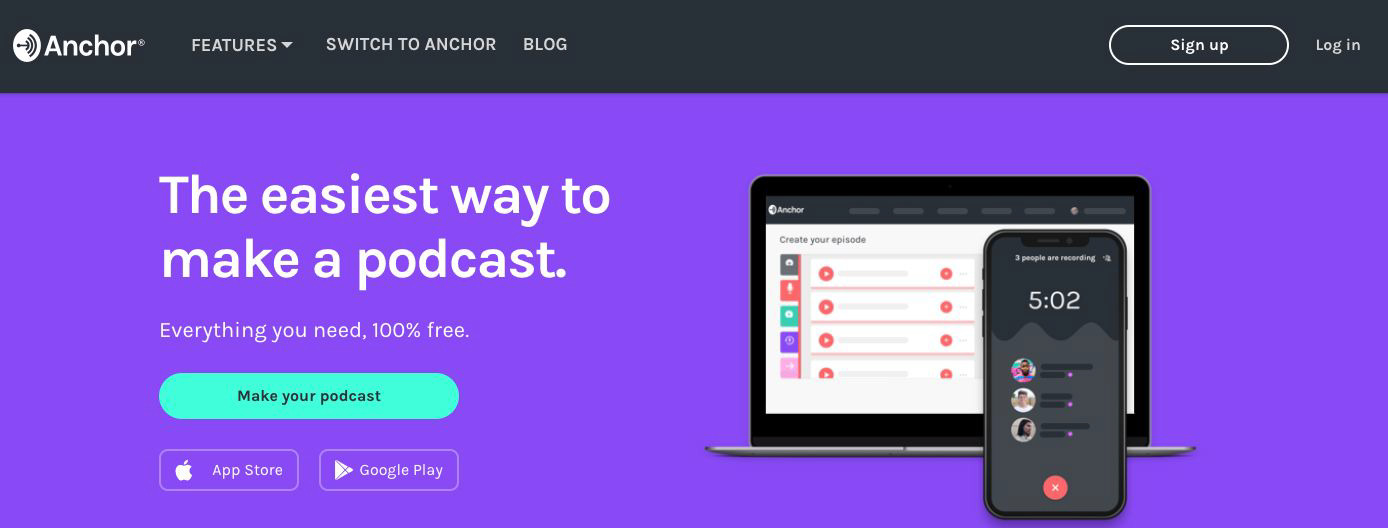What is Link Building?
Link building is the process of getting links from other websites to your own. It is very important to your whole search engine optimization strategy.
Creating useful content that is related to your company, its products, and services will be required before you can start implementing a link building strategy.
Backlinks, or links from another website to your valuable content, are earned when somebody links to your useful resources.
Link building helps to expose your brand to a much bigger audience while also increasing the domain authority of your website, which can help you rank better in search engine results.
Why is Link Building in SEO?
Links are still the number one ranking factor Google’s algorithm uses to determine the SERP results. If you want to rank higher you have to build links. It’s been this way since day one and it’s not going to change — at least not anytime soon.
While the fact that links are the number one signal hasn’t changed, the art of link building has. It’s all about strategically acquiring authoritative links.
Quality over quantity, so to speak. The majority of people that try to build links give up before they gain traction and experience results. Why? Because it’s not easy and it takes time.
Today, people want results immediately — and with no work involved. This is also what leads people to try to take shortcuts, and they end up falling for low-quality link-building services.
Private networks of sites with no traffic. Spammed blogs with an article talking about DUI lawyers between blogs about viagra and CBD oil.
1. Interlinking
It’s surprising how often link building on your own website is missed due to how simple it is to perform. Do you have a service page? Pages dedicated to products? Are there subcategory pages?
When it comes to interlinking, there are countless ways to do it while avoiding the look of being extremely spammy.
Within your blog’s content, interlinking is the most effective method. SEO is the best use of your time and money if you write new content for your blog on a regular basis.
It also helps you get more organic traffic, but it also gives you valuable content that you can use in your outreach efforts.
Finding high-quality websites ready to link back to your site will be a challenge. No need to connect directly to a homepage unless it’s a news article or a major news item that is trending.
Most large authority publications have altered their policy to ban homepage links.
Websites have been flooded with calls for guest posts, link swaps, and even outright scams for a link to their homepage. This has led many publishers to make all of their links no-follow instead of just stopping them.
So, if you’re going to do outreach, you’ll need some good blog posts to pitch. This must offer something of value to the website and give it a reason to refer to it.
When a website receives hundreds of pitches every day, what about your blog articles, which might make it difficult for them to reject your pitch?
As soon as you get started on your blog, start integrating your material with other relevant content on the site.
If you already have blog posts, go through them and search for places where you may link to other parts of your site. As your website’s authority grows, this helps to spread that authority more evenly across the site.
As a result, all of your pages will benefit from an increase in Google’s organic search rankings.
-
Silo Linking
You may also use a silo content strategy to interlink your website and develop a solid SEO foundation. Some of the most popular websites are putting a lot of time and money into this tactic.
As long as you are posting high-quality resource pages on your site, you shouldn’t have to worry about a Google penalty.
If you’re putting out low-quality spun stuff, perhaps, but if you’re developing good content assets and pointing to them using this method, you’re not going to have any problems.
The more you understand how to develop silo pages and win connections from websites that consider it a useful resource, the more you can use them to send link juice to other pages that target lower-competition search terms.
If done on a large scale, this has the potential to have a significant impact on your organic traffic growth. It can be applied to any industry or niche. All you have to do is think beyond the box.
The top-of-the-silo resource page for a small local landscaping business may be allocated to lawn care suggestions, with links leading to specific pages for the communities they serve in the area.
As long as it looks natural, it can be done without giving the look of being a link-building tactic. Make your core keyword pages into mega-resource pages and then link out to pages that target the long-tail versions of your keywords.
This can be accomplished in a variety of ways. Look at the footer of Barstool Sports and you’ll see how they’re sending juice to their pizza-rating website.
Is that done for SEO purposes? Of course.
They realize that their authority can be used to make those pages rank, generating traffic to their pizza app site, which ultimately results into purchases and customers.
2. How to Identify “Good” Links for Maximum SEO Gains
There are many things to consider when evaluating relevance. Many people will just look at some vanity third-party metrics and declare a link relevantly, but it doesn’t work that way.
If you are building links for a local pizza restaurant you’d rather three links from popular food review blogs than a single link from Forbes.
Why?
First, the three food review blogs are more relevant, as they relate to food, and second, the chances of those links being do-follow are much greater.
A local pizza restaurant has no business being mentioned, let alone linked to by Forbes unless they did something extraordinary that warranted large-scale national media attention.
Also, Google has devalued links from large media sites because of how easily they are acquired (as long as you have deep pockets), so again, the relevancy of a link comes into play now more than ever.
Here are some of the things to look at in order to determine if a link opportunity is relevant beyond just the niche of the website.
These factors contribute to their desirability.
-
Anchor Text
Some link opportunities will provide a more lenient opportunity when it comes to anchor text. What is your goal? Are you looking for brand name anchors? Very specific keyword anchors? Generic “here” or “more info” anchor text?
If your goal is just to increase your website’s authority then anchor text is irrelevant, but if you are targeting specific inner pages and want exact-match anchors to push your SEO to the limit, then your options are going to be much more limited.
-
Inbound and Outbound Links
A very quick way to see whether or not a blog is legit or just a network blog is to look at its inbound and outbound links. Is it only linking to websites to pass SEO value? Is it linking out to resources naturally? This is where common sense comes into play
.
If a blog’s articles are just linking out to DUI law firms and CBD products, for example, that is a red flag. Also, if there are no inbound links to a site that is also a red flag. Look at large outlets and popular blogs.
They receive natural links. Links on real websites are much more desirable — and safer. Learn how to quickly spot real sites and those that are questionable.
-
Page/Site Content
Remember when the standard for all blog content was 500 words? Then it was 750. Then 1,000. Now it’s over 1,000. this is some silly rules SEOs made up. Look at the biggest sites in the world and you will see a huge range. From 250 word articles to 3,000-word articles.
There are no patterns. Why? Because they are real sites. If a blog has nothing but 500 word posts it’s a red flag. While the vanity metrics might appear nice, when you look under the hood you realize it’s a complete turd.
Take time to glance at each site target’s content.
-
Indexing Percentage
Look at a site’s most recent posts and copy the first paragraph and place it in Google search. Does the article show up? If yes, that is a good sign. It means the site’s content is indexed fast.
If it doesn’t grab an article from the past week. If it shows up the indexing might be a little slow, but that’s nothing to be too alarmed about. If content from a week or two ago isn’t indexed that’s a red flag.
You will then need to do a little digging. Make sure you are only building links on websites that have its content indexed — and fairly quickly.
-
Interlinking Structure
It’s very important and any real website interlinks because of its benefits. If a site doesn’t that’s a major red flag. If a site only exists to sell links they have no interest in interlinking — their own SEO is of little concern to them.
If you notice that they do interlink throughout their blog that shows you that they are spending the time and effort to improve their SEO, which is a great sign that it’s not just a network blog.
-
Referral Traffic
Many people don’t consider referral traffic as a benefit of SEO, and those that think this way miss out.
Again reference to Forbes and use a local pizza restaurant as an example. If they land a link on Forbes the odds of someone local to them seeing it, clicking on it, and then going in to order a pizza is slim to none.
But, if they scored a handful of links from local media outlets (local news stations, local food blogs, etc.) then not only get the link value but if those links are contextual in real content, local traffic will see it and possibly click-through, some of which could possibly turn into customers, making those links much more desirable.
As you can see, more factors need to be looked at and evaluated than just “DA” and third-party metrics — a topic I’m about to dive into next.
3. No-Follow vs. Do-Follow
The no-follow vs. do-follow debate has been going on forever, and while do-follow links are more desirable as they pass authority and “juice,” you cannot simply ignore no-follow links.
Google constantly adapts and some of the most powerful links are no-follow. An example is Wikipedia (they follow internal links but any link to an external website received the no-follow attribute).
When link prospecting the easiest way to see if certain links are do-follow or no-follow is to install the Moz toolbar. It’s a free Chrome browser extension that can be installed here.
Sign up for a free Moz account and you can easily see the metrics of any website you are browsing and also quickly highlight all no-follow or do-follow links.
Here is an example of the tool being used in a NY Post article. As you can see the contextual link within the content is do-follow:
With most of the website links that are considered “highly desirable” these days being no-follow, it’s kind of changed the approach. Google definitely values them,
but from an SEO standpoint you need to consider the following:
-
Diverse natural link profile
Having 99% do-follow links just isn’t believable, under any circumstance. Links from social media profiles, most business directories, blog comments, forum links, etc. are all no-follow, and they have always been no-follow.
A natural profile includes no-follow links, and some of them hold more weight. It really comes down to how difficult it is to get the link and/or the requirements to get said link.
The Better Business Bureau is a great example. A link to your website from an Accredited Business profile is no-follow but the only way to get that link is to be a real business and meet the qualifications of being an Accredited member.
A fake business or a low quality lead generation landing page cannot get a link from there — not even by paying. Therefore Google places a lot of weight on BBB links.
-
Potential for referral traffic
Forum links are a great example. Sure, a link on a forum might not give you do-follow juice, but if it’s a high traffic forum with an audience interested in your product or service, it’s a good link. SEO value might be very minimal, but it’s going to get you more traffic, repeat visitors, more organic searches with click-throughs, etc.
From a business standpoint, this kind of link with high referral traffic benefits is highly valuable in terms of generating business.
4. UGC Attribute
Google announced the UGC (User Generated Content) attribute, as a tag that could be used to identify links on a website that are placed by the users/visitors, rather than the actual website itself.
It’s an attempt to devalue links that anyone can drop simply by registering an account. You can quickly inspect a link and see what attributes if any, a link has.
Google made it very clear that publications and sites didn’t have to make changes, go back and assign the UGC tag to links, or even use it in the future.
Basically, it’s available to use if anyone wants to.
The default WordPress editor now allows you to assign the no-follow tag and the sponsored tag to links, but not the UGC tag, further proof that it’s not being used nor anyone is paying attention to it. This one was a flop.
5. Sponsored Attribute
The “sponsored” attribute was announced at the same time as the “UGC” attribute. This one is being used more frequently, especially by bloggers, and it’s now a standard link option within the default WordPress editor.
Any time you are looking for guest post opportunities make sure to look at recently published content. Inspect the links and look for “rel=sponsored” in the HTML code. I would highly suggest not paying for links that get tagged with this.
They are essentially telling Google that you paid for the link, which at this point is worthless.
6. Directory Link Building
Directory links, even what most would consider “low quality” can help your SEO. Why? Because a website isn’t going to naturally have a squeaky clean link profile, filled up with only authority links. It just doesn’t happen that way.
If you really take the time to dig into the link profiles of the best websites in terms of how they rank for difficult terms and how much organic traffic in total they pull in you might be shocked.
How do they rank and have low quality links?
They aren’t building all of the low quality links themselves. There are always going to be spammy scraper websites that steal your content and throw a source link back to the original.
understanding that it’s going to happen. Just because a link isn’t from Forbes or Tech Crunch doesn’t mean it’s useless and won’t help your SEO.
If someone owns a business and joins a forum or group that allows them to put a link in their profile they are going to do it.
They are also going to do it without checking the Domain Authority, whether or not the link is do-follow or not, or what the Spam Score is on the domain.
Why not ? Because the normal person doesn’t think like that.
If they see a field to enter a website they are going to do it, in hopes that someone sees it, and clicks on it. That is why natural link profiles have these types of links in them.
If Bob owns an auto parts website and joins a baseball forum they are going to put their website link in their bio naturally, without thinking about SEO.
7. Social Media Profiles Links
Back in the day, Google’s search results were very simple. There were ten organic results per page, and the goal was to fill that first page up with your own content. It was beneficial to own or have access to all of the web properties on the forest page of Google.
In the early days of SEO, we would create Blogger pages and other high authority web properties. Remember the term Web 2.0? That is a blast from the past for some! Well, today the search results are much more complicated.
We have ads dominating the top of the page, Knowledge Panels on the sidebar, local maps, video results (from YouTube), and even “position zero” information. There are very few spots for true organic content on page one now.
These days, web properties that will rank on top are social media profiles. Consumers use social media as a communication avenue and some even communicate with businesses via social media.
Take a look at Kylie Jenner’s brand. If you Google “Kylie Cosmetics” you will see her website under the ads and then the only other truly organic content is the brand’s Twitter and Instagram profiles:
Not only does this strategy help you easily occupy all of what is left for true “organic” first page real estate, but you also present search traffic with more options to click-through.
Maybe they weren’t in the buying mood, but see a tweet in the Twitter feed that catches their attention, and they click-through, eventually landing on your website and converting.
It’s a major missed opportunity, and it doesn’t matter if you don’t plan on using a particular network. If you complete the profile fully, include your business name, a bio with contact details, etc. it’s going to rank.
At the very least, register, complete, and optimize profiles on the following:
It takes a few minutes to do. Be thorough, as the more detail the better. Not just for Google, but for anyone that lands on them. Have a profile image that is consistent across all, along with a bio, a call-to-action, and a website URL — because these links do help.
8. High Authority Podcast Links
Podcasts are a great way to build an audience and awareness for your business, but most people don’t have the time to record and produce a podcast.
But, that doesn’t mean you can’t take advantage of the link building opportunities that come with having a podcast.
You will want to set up an account with Anchor.FM, a top podcast platform and distribution network. It’s free. It’s easy.
You will want to come up with a podcast title that is relevant to your niche. Also, make sure the name isn’t being used already. Just search iTunes first. Once you have a great name you will want to write a podcast description.
Make this as believable as possible. A nice paragraph explaining what you will be talking about is sufficient. Then you will need to come up with your podcast cover art. Make this in a free tool like Canva. Select the best category for your podcast and include your website URL.
In order for Anchor to distribute your podcast, you need to have a trailer uploaded. Don’t worry, this is simple. The easiest way to do this is to download the Anchor app on your phone and login and record your trailer. The instructions are simple.
Once you have that done you can submit it for distribution and you can monitor what networks pick it up. In your Anchor dashboard, you will see your distribution results, and you can also access your RSS feed, which you can then submit to other channels and players if you want.
9. Press Releases
When you understand how to properly leverage press releases they can be great for three reasons:
- Link Building
- Referral Traffic
- Building Trust and Credibility
A quick Google search will turn up dozens upon dozens of press release distribution services. Some are priced as low as $49 and some as high as $2,000. This is one instance where you don’t necessarily get what you pay for.
You might think that spending $2,000 to distribute a press release will land you on some pretty amazing sites, while a $49 service will land you on junk. Well,.
When using press releases for links it’s important to do it for brand mentions and naked URLs only, avoiding spammy exact match anchor text. Some press release services will allow you to insert as many as five links into the PR.
I suggest doing no more than three links in each release, with the following format:
- Brand Name
- https://www.yourwebsite.com
- www.yourwebsite.com
This is the best approach for branding, as well as avoiding any Google penalties. When you distribute through real platforms your release will hit some guaranteed, but it’s also sent through the wire, where reporters and other outlets can pick it up.
You want to create a release that has an appealing angle, in an attempt to get picked up by as many media outlets as possible. If you are going to take the time to write a PR and pay for distribution why not try to leverage it as much as possible?
There is no reason to risk it. A single brand name anchor and two naked URL variations are the smart and safe approach. It’s best for branding and it’s best for SEO.
10. Linkable Content Assets
If you build amazing content the links will come.
There has always been one differentiator when it comes to the sites with the better link profiles, and that was the content on their website. It doesn’t matter if we are comparing local law firms or global consumer brands.
The websites with the better blog content always have better links. Are they better companies? No. They are just better at creating content that is attractive enough to other websites, resulting in them linking to it.
Whether you are trying to gain links naturally from other websites stumbling on your content or via outreach — you need something unique and special.
A few tips:
-
Content Quality
Don’t publish low quality content on your website for the sake of “posting content” because you see it suggested by every SEO guru
.
If you are going to do it, do it correctly. Many businesses post crap and wonder why they don’t see any results. If you are going to invest in content marketing hire the best or fully commit to writing in-depth content that provides value.
-
Quality over quantity
Quality over quantity applies here. we have seen websites that post a new blog every day that never earned a single natural link, and then websites that made something so epic that it continues to earn them natural links three years down the line.
Great content assets can become evergreen link magnets.
-
Long-term Goal
Approach building content as a long-term play. Doing this helps you think of special content assets you can build that will contribute to your SEO and link building success for years to come.
11. Write Content for Pre-Determined Link Targets
Sometimes you need content written for other publications, not necessarily your own blog. This could be for a contributor account you are trying to secure or a one-off guest post you want to submit.
It doesn’t matter if you are going to write the content yourself or hire a ghostwriter to do it, if you submit content that already “fits” the target in terms of style, format, and voice, it will greatly increase the odds of them accepting your pitch and publishing your content — while also hopefully scoring you a link.
These are the most important features to mimic when writing content for a specific target:
-
Title Style & Format
There are several different styles when it comes to titles and their formatting. Some Capitalize all first letters, while others only capitalize the first letter and all other words are lowercase letters.
Little details like this mean a lot to editors and can mean the difference between being accepted or rejected.
-
Content-Length
Pay close attention to the content length. If they publicly accept guest posts, look for their guidelines page. If they say 800 – 1,200 words, make sure it’s at the high end, but don’t go over their max.
Doing that gives them more work because they have to trim it down.
-
Voice & Tone
Every blog has a tone or style, and its readers get used to that. If you submit a post that features the same voice and tone it gives them less work, as little to no editing will need to take place.
If a website can literally copy and paste a submission they are more inclined to publish it.
-
Interlinking
Look at a few examples to see what they tend to favor in terms of interlinking. Some will always interlink for the first few links, while others are more random.
Some will have a minimum number of links that go to other posts, while others do it here and there. Identify patterns and replicate them.
This comes back to making less work for them. If they receive a pitch that is already linking to relevant content on their site they can push the “publish” button faster. Remember, they love free content.
It drives page views and ad revenue. But, if they have to spend a lot of time editing it ends up costing them money to publish your post.
-
Heading and Subheading Formatting
Just like titles will vary from publication to publication in terms of capitalization, so will headings. Spending a few minutes making sure you understand how a blog formats its content goes a long way in helping you get your pitch and submission published.
-
Paragraph Length
The average blog reader has a short attention span. Over the years many blogs started to favor paragraphs of 2-3 sentences over huge paragraphs. They found that visitors engaged longer with content that was broken up into several smaller paragraphs.
12. Get Wikipedia Links
There is a big demand for Wikipedia links, and for good reason: they are very authoritative. This also backs that no-follow links that come from legitimate sources still provide a lot of SEO value.
There is also a lot of misinformation regarding creating Wikipedia links. You see, Wikipedia is an open source platform and they welcome corrections, edits, and the addition of information, as long as it’s legitimate.
But, like many other things, marketers messed it up. Now there are things in place to prevent spammers from dropping links. The moderators and long-standing community members take their job very seriously.
They are volunteers and take it very personally when someone attempts to game Wikipedia.
Anyone can create an account on Wikipedia. The mistake many make is trying to drop links right away after registering an account.
The best approach is to create an account, take time and let it age. Login here and there. View pages, and then make an edit related to your niche, but one that is very obvious and related to news or current events. Link to a news report and not a business.
Do this over the course of 12 months to really age your profile and make it look legit. But, since nobody likes to wait, you can also do something else in the meantime, and that is buying an aged Wikipedia account.
There are many online marketplaces that buy and sell online assets and accounts. Try to get one that has done previously successful edits in categories relevant to your niche.
This will make it look legit. You also have to be smart in regards to what you are linking to on your website. Write an amazing resource, guide, or article, but don’t publish it fresh.
That will look suspect, linking to a brand new piece of content. When you publish it, backdate it — and far.
If a Wikipedia OG user or editor sees a new link placed and notices that it a) is relevant, b) is a source that makes the Wikipedia entry better, and c) isn’t a brand new piece of content it is less likely to raise any red flags.
So, start a new account on Wikipedia and age it, while at the same time purchasing an aged user account. Don’t get discouraged if your link is removed.
A random editor might not like it, and oftentimes competitors will try to get them removed — because Wiki links are very powerful.
Tip: if a link is removed don’t try to place it back in the same spot. If an editor removes it and sees that you place it back right away they will delete it again. Most people that place links in Wikipedia articles are doing it to help, and not for SEO gains.
Therefore, they aren’t constantly monitoring whether or not the link is still live. Appearing genuine and natural is key.
13. Google Alert Link Building Strategy
use Google Alerts for two reasons – link building and referral traffic.
You can set alerts for anything. Whenever Google detects new content indexed that contains the keywords or phrases in your
alert you will receive an email notification and a link to the content.
This presents you with an opportunity to:
-
Earn Links
Let’s pretend you own a fitness blog and you are constantly publishing long-form in-depth articles that feature workouts, healthy eating tips, weight loss advice, etc.
The content provides a lot of value and is something a new visitor would consider helpful. You would want to set up Google Alerts for things like:
1. Weight loss journey
2. Weight loss help
3. Diet and exercise
4. Workout routines
5. How to lose weight
There is an endless number of topics, but that gives you an idea of what you would want to target. Now, you’re going to receive a lot of alerts, and this is good.
When you dive into your alerts look at all of the URLs and ask yourself these questions:
1. Is this a quality website that I’d like a link from?
2. Do I have an article on my blog that could complement and enhance a section of the content?
If the answer is “Yes” to both, you want to pitch the website ASAP. A quick message via their contact form is all it takes. Short and sweet is always the best:
You aren’t just asking for a link. Make it sound like you are offering them a favor by allowing them to link to it. That simple little language tweak will help you land a much higher percentage of these types of requests.
And remember that it’s a numbers game. But, when you target the right alert phrases you will not have a shortage of opportunities.
-
Drive Referral Traffic
While doing the steps above look to see if the article allows comments. If so, create an account using a free email (Yahoo, Gmail, Hotmail, etc.) and not one with your website’s domain. Leave a comment that praises the article, while referencing several points that you like.
Then find a way to naturally link to a relevant article on your website. This isn’t for SEO value. This is purely to attract referral traffic. You are already taking the time to look at the piece of content in order to identify a link opportunity.
It takes just a couple of extra seconds to see if there is also an opportunity to drive traffic to your website in the event that you don’t score the link.
14. ‘Now Hiring’ Link Building
A very easy way to score a handful of nice links is to create a “Now Hiring” page on your website that lists all of your current openings. Now, you can do this even if you aren’t technically looking to hire anyone.
If you are, great. Create a dedicated page with your open positions. You can then optimize the page and even pull in organic traffic consisting of potential job candidates. If you don’t have any openings, think about what tasks and jobs you outsource.
Graphic designers? Social media managers? SEO? Content writers? Create a job listing for all of these, complete with a way for the person to apply, attach a resume, etc. The more realistic you make this the easier it is to score links using the ‘Now Hiring’ method.
There are several job board websites that you can submit your available positions. If you create a dedicated page like suggested you can simply link to it. It’s very hard to get a homepage link or a link to a generic contact page doing this.
But, they will almost always allow you to link to a page that lists all open positions, job descriptions, as well as a way to directly apply.
Even if you go the blackhat route and create a fake ‘Now Hiring’ page you can set the form to submit to an invalid email address.
This way it doesn’t interrupt your business. It’s important to put some kind of disclaimer near the form submit along the lines of, “We only contact those applicants we deem fit and wish to invite to the next round of interviews.
If you do not hear from us please do not contact us directly to inquire about the status of your application.”
The best approach is to sit down and hammer it all out in one sitting. Some of the current free job posting sites include these fifteen options:
- Jobvertise
- Hubstaff Talent
- Handshake
- AngelList
- Chegg
- Indeed
- PostJobFree
- Learn4Good
- Startupers
- Jora
- Scouted
- JobSpider
- Ladders
- Jobxoom
- ReliefWeb
These types of links are also a good signal that the business is legitimate. After all, why else would they be posting open jobs, right? This is how SEO needs to be approached these days — with common sense and logical thinking.
15. Discount & Special Offer Link
There are numerous coupon codes and discount websites out there, and the majority of them will allow people to submit discount codes as well as a link to the website where the offer can be redeemed. Why? The more offers, stores, discounts, etc. the more potential organic traffic they will attract.
Most of these websites are monetized via Google AdSense, so more page views mean more advertising revenue.
They also tend to collect emails, which most will monetize by sending out affiliate offers or sell ad placements on a weekly couponing or special savings newsletter.
Not only can this earn you links, but you can also pull a lot of organic traffic if you optimize your offer and listing correctly.
Don’t just slap it together — think it out and write a description that targets many long-tail versions of keywords someone would be searching for when looking for discounts and coupon codes related to the products or services your website offers.
There are always new coupon and deal websites popping up, and a quick Google search of “submit coupon deals” will turn up some results and you can fall down a deep rabbit hole — there are plenty of them. There definitely isn’t a shortage.
Here is a 10 list to get you started:
- Retailmenot
- savings.com
- coupons.ca
- mycoupons
- couponcraze
- hip2save
- dealtaker
- allonlinecoupons
- webbyplanet
- savingsmania
Remember, links are great, but This strategy drive thousands of visitors a month to e-commerce websites, which translated into sales that would not have happened otherwise.
Check more relevant Articles:
How To Build A Web 2.0 Private Blog Network
How to Use Keywords to Optimize Your Blog Posts
7 Best Alternatives to Google Adsense
How To Do SEO Competition Analysis The Right Way
How to Build a PBN (Private Blog Network) in 2022
Conclusion
Building links has always been a difficult and time-consuming part of launching a new website. This is due to the fact that having a decent site alone is not enough; quality backlinks from authoritative sites are just as crucial.
Using the strategies presented here, you can increase the authority of your blog by attracting high-quality backlinks. In the long run, it’ll happen.
To reach the top of Google’s search results for a certain niche, all you need to do is develop a website, stick with it, and implement the link building strategies described here.
Consider Following a Course ?
With Lifetime Access ?
We have been the number 1# platform for delivering most demanding course. Becoming Lifetime Member , You will receive all the Premium content For FREE

Consider Following a Course ? With Lifetime Access ?
We have been the number 1# platform for delivering most demanding course. Becoming Lifetime Member , You will receive all the Premium content For FREE







